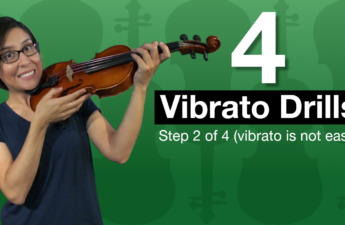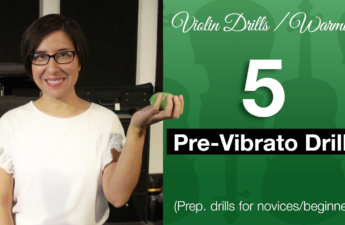My first completed year of learning the violin was shared with my very first owned violin – the Benjamin Adams VN75 student outfit. It’s one of the cheapest outfits offered by Sam Ash music stores at a whopping $79.99. It includes a very sturdy case, bow, and light rosin. I used this violin to start up my learning and it has gone through many transformations. If you would like to see and hear examples of how this violin sounds in the hands of a beginner violinist, visit my play along videos that are listed under the Suzuki Book 1 links.
One pro to point out is the inexpensive price for what you get. Everything works as it should. All you have to do, is prop up the bridge, tune the violin, apply lots of rosin to the bow and the violin will be ready to play. The sound is pretty decent, and for a beginner like myself, it was a good start. But with time, I used it more and more and started to notice a few issues. There were a total of 5 issues I needed to address to make this violin to be very playable.
ISSUE 1: The tuning pegs were not properly fitted.
To initially tune the violin, you will need a lot of patience and possibly peg drops. I’m assuming this is a common issue with factory ready violins that you don’t purchase directly from a violin shop. The pegs tend to unravel very easily. Eventually I purchased peg drops, applied it to all the pegs and the violin stayed in tune much longer. But there’s a downside of using peg drops – you will no longer have an easy time using your pegs to tune the violin. The pegs don’t turn easily and you run the risk of breaking your them – which is what happened to another cheap violin I purchased during the year. Believe me, I learned my lesson, AND most likely I will never use peg drops ever again. Do not force turn your pegs! Since then, I did some research as to why violin pegs tend to unravel and become difficult to turn. The problem is usually unfitted pegs. The pegs should be properly fitted and you shouldn’t have to struggle to turn them. I also found a great product called peg compound. It the best of both worlds, it allows the pegs to smoothly turn and at the same time the pegs don’t unravel. I fitted my pegs into the scroll by lightly sanding down each peg, and I also applied compound to each of them. With that adjustment, I have not had any trouble tuning my violin using the pegs.
Once you get your violin tuned, it is common to use the fine tuners for small pitch adjustments. Which reminds me – If I may be a little picky – I noticed that the e string fine tuner knob has always been a little troublesome to turn. But maybe it’s just this violin.
ISSUE 2: The Tailpiece Fastener Broke
To my surprise, a few weeks after purchasing this violin, it started de-tuning severely every time I played it. When I would attempt to play a song right after spending so much time tuning the violin, it would suddenly snap or click and again it was completely out of tune. I observed that the click sound came from the tailpiece. I carefully disassembled the tail piece and found out that the tail piece fastener was stripped. This is a result of using cheaper parts to keep costs down I’m sure. Unfortunately, I had to put my practice on pause.
I replaced the fastener with a better quality one. If you replace the fastener yourself, it will only cost about 5 dollars for a good quality fastener. If you take it to your luthier, it would cost about 15-25 dollars.
ISSUE 3: String were not very good quality
I also went ahead and ordered better strings for the violin. Again, since it’s a very low budget instrument, I assume it didn’t come with the best strings. The strings are very easy to change out and if you get decent strings like the ones I got, you’ll be playing again in no time with a better sounding violin.
ISSUE 4: Strings sit too high above the fingerboard
The strings felt like egg slicers on my fingertips because they sat too high above the fingerboard. As a result my fingertips became very sore. I understand that we all develop calluses when playing stringed instruments, but this was beyond developing calluses. At one point, I was a afraid to play because my fingertips were constantly sore. Around that time I purchased a used violin from Craigslist for only 25 dollars. I found out that the 25 dollar violin was easier on my fingers, and when compared to the Benjamin Adams, the nut was far lower and the fingerboard itself sat higher (closer to the strings). I found out that the finger board is suppose to be about 20-21 millimeters high. The height the Benjamin Adams VN75 fingerboard is 17 millimeters. Not good. This makes it very painful to play and impossible to play 3rd position. I lowered the nut and the bridge to compensate the low fingerboard. I lowered the bridge about 2mm, and the nut as low as the width of a thick business card. Also, when I made the nut and bridge adjustments, I found that the strings were not properly spaced at the nut. Since I had to file down the nut, I had to re-create the slots for the strings. I’m not sure if this makes it even more difficult to play, but I went ahead and properly distributed the strings according to my research on proper string spacing at the nut.
ISSUE 5: Non-ebony fingerboard and fittings
While adjusting the nut, bridge, and pegs, I found out that these parts were not ebony wood. Therefore, when you want to clean the fingerboard or when your play for a long time, the dyes will start to come off. So beware non-ebony parts. This is important because you want to able to play without getting paint on your fingers and it’s nice if the fingerboard stays black every time you clean it. From a year’s use, I have two permanent scratches that expose the wood color on my fingerboard – which is not very pretty.
PRO: I know what I want for my ideal violin
The biggest PRO out of owning the Benjamin Adams VN 75 was the learning experience. The more I played, the more I learned what I would want out of my ideal violin. The sound is decent enough for a beginner like myself, and with all the adjustments I made, AND all the accessories I swapped out (such as the bow and chin rest), it has become a very enjoyable instrument. Would I recommend this violin for a every beginner? Definitely not. If all you want to do is play the instrument without any snags, this one is far from ideal. For me – I was prepared to tear down this violin piece by piece if I had to. I did not feel any remorse in taking it apart and modifying it myself. It gave me a hands on learning experience of what make a good violin, without the fear of destroying an expensive investment. For a beginner that doesn’t mind taking apart and putting things back together – this is an ideal violin.
In my opinion, the best way to purchase a violin is from real violin shop. Try out some their violins within your budget, or just follow the advice of the luthier. They are usually very helpful and would able to recommend a good starter kit to any beginner. See what’s out there. When you purchase a violin from a violin shop, even if it’s inexpensive, at minimum you will get a very playable instrument that’s set-up, ready to play, and will last as long as your beginner phase (which takes a few years).
After a year of use, I am ready to discover a better violin that I can grow with. Therefore, as part of my one year celebration, I am going on a shopping spree to find my next violin. For my next violin, I plan to invest more, and I hope to find an instrument that will stay with me for many years to come. Off to several violin shops I go!


